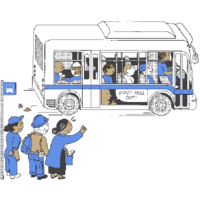- Monday, January 31, 2011, 7pm
- Anthology Film Archives
32 Second Avenue (@ 2nd Street)
New York, NY 10003
Give and Take: People and Buildings Film Screening

We showed two films about the world of welfare: Warren Wallace's seldom-screened Superfluous People (1962), and an excerpt from Frederick Wiseman's Welfare (1975). Wallace's award-winning film turns an eye on overlooked urbanites – from "well babies" abandoned at the hospital to families displaced by urban renewal. Clergymen, city planners, and social workers weigh in on society's responsibility towards its "superfluous people." Wiseman's provocative film takes us into the heart of the welfare office, where the safety net is translated from theory to practice. Together, the two films address the tension between the moral obligation for social services and the dizzying bureaucracy that administers assistance day-to-day.
After the screening, there was a special guest appearance by CUP's newest youth education project: "The Road to Cash Assistance," and a post-screening discussion led by Premilla Nadasen. An associate professor of history at Queens College, Nadasen has been exploring the history of welfare for over a decade. Her book, Welfare Warriors: The Welfare Rights Movement in the United States, outlines the ways African American women on welfare forged a feminism of their own in the 1960s and 70s. She recently co-authored Welfare in the United State: A History with Documents.
The People and Buildings Film Series is made possible in part by public funds from the New York State Council on the Arts, a state agency. Superfluous People Courtesy of the Reserve Film and Video Collection of the New York Public Library. This program was curated by Valeria Mogilevich.














